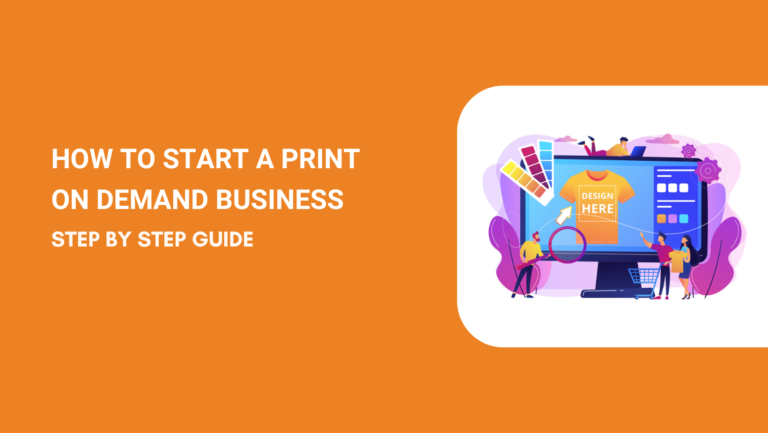Starting an online business doesn’t have to mean stocking up on inventory or handling shipping logistics. That’s where print on demand (POD) comes in.
It’s a low-risk business model that lets you sell custom-designed products without worrying about storage or fulfillment.
Whether you’re an artist looking to monetize your work or an entrepreneur searching for a scalable eCommerce idea, POD offers a flexible way to build a brand.
But how do you actually get started?
In this guide, we’ll walk you through the key steps to launching a successful print-on-demand business—from choosing the right niche to setting up your store and marketing your products.
Let’s dive in!
What Is Print on Demand Business Model?
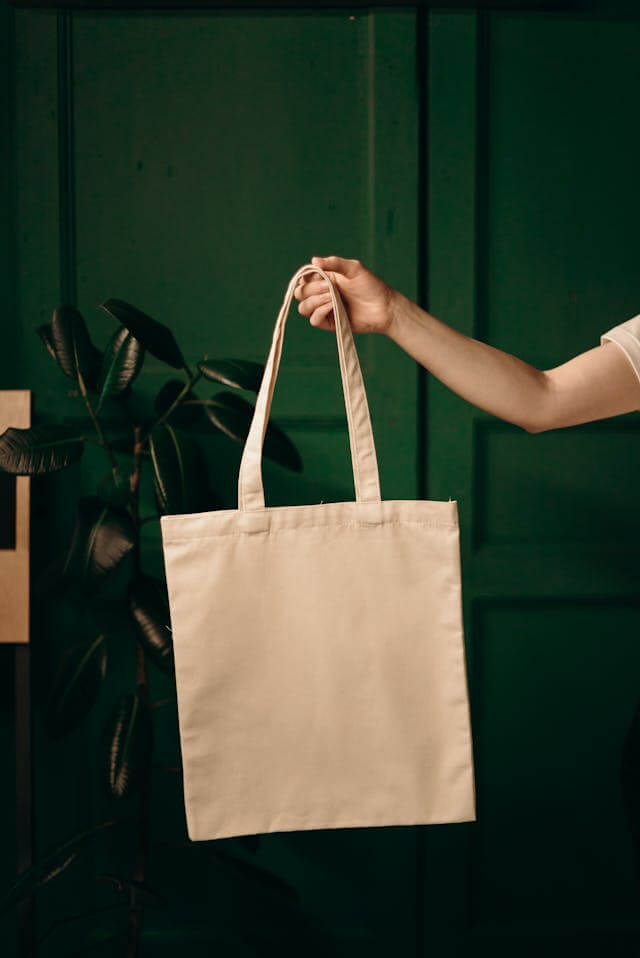
Print on Demand (POD) is an eCommerce model where you sell customized products without holding inventory. You partner with a supplier who prints and ships items like t-shirts, tote bags, and posters only when an order is placed.
There are two ways to customize these products:
- Consumer personalization – Customers add their own designs, text, or images.
- Your own designs – You create unique designs to sell.
Since production happens only after a sale, there’s no upfront stock investment.
Plus, your supplier handles printing, packaging, and fulfillment—making POD very similar to dropshipping. It’s a low-risk way to start an online business with minimal costs.
6 Simple Steps to Start a Print on Demand Business
Starting a POD business can look tricky at first, but in reality, it’s a fairly simple process. All you have to do is follow these simple steps and you’ll have your own Print on Demand store in no time:
Step 1: Brainstorm Designs and Ideas

The first step of starting a POD business is to brainstorm creative designs.
In case you’re lacking inspiration, here are some tips to help you get your creative juices flowing:
- Study Your Competition – It’s fine to take inspiration from other stores. However, make sure that you don’t copy-paste the exact design as that can potentially get you into legal trouble.
- Create Multiple Drafts – Rather than brainstorming for that one “perfect” design, start by creating multiple drafts. Producing more ideas can get you closer to your actual target because always remember, “quantity breeds quality.”
- Explore New Trends – Explore hot-selling designs among your target audience. For example, if you’re planning to sell t-shirts, then check trending designs among celebs and add your own twist to them.
Brainstorming ideas is unarguably the hardest part of starting a POD business. Even if you’re allowing customers to create personalized products, it’s still essential to add premade designs to your store to target impulse buyers.
Lastly, always remember that not all of your designs will succeed. Trial and error is inevitable so don’t let failure discourage you.
Step 2: Decide What Product to Sell

There’s a common misconception surrounding POD businesses that you can only sell products like t-shirts, mugs, and hoodies.
And while these items are insanely popular, there are other various products that you can include in your POD shop such as:
- Face masks
- Tote bags
- Socks
- Bedsheets
- Posters
Aside from printed products, it’s also possible to sell custom engraved jewelry, given that you can find the right POD jewelry companies.
If you’re unable to decide what to sell, start by asking yourself:
- What are you passionate about? Designing for a niche you love makes the process more enjoyable.
- Is there demand for this niche? Use tools like Google Trends or Etsy search to see what people are looking for.
- Who is your ideal customer? Define their age, interests, lifestyle, and buying habits.
For example:
- Niche: Fitness enthusiasts
- Target Audience: Women aged 20-35 who love yoga and mindfulness
- Product Ideas: Yoga-themed t-shirts, tote bags, and water bottles with motivational quotes
Marketplaces like Etsy and Amazon also allow users to offer POD services. Explore the sites to see the best-selling products and also go through customer reviews to learn the weaknesses of your competitors.
Keep in mind that regardless of what you’re selling, try differentiating yourself from the competition.
You don’t necessarily have to introduce a new product to do that. Just focus on providing superior quality, and you’ll automatically attract buyers.
Step 3: Research and Choose a Print on Demand Supplier
Once you’ve defined your niche, the next step is to find a reliable print on demand (POD) supplier.
Your supplier will handle product printing, packaging, and shipping, so choosing the right one is crucial for quality and customer satisfaction.

What to Look for in a POD Supplier
- Product Variety – Does the supplier offer the products you want to sell (e.g., t-shirts, mugs, posters)?
- Print Quality – High-quality prints keep customers happy and lead to repeat sales. Check reviews or order samples.
- Fulfillment and Shipping Times – Faster shipping improves customer satisfaction. Look for suppliers with fulfillment centers close to your target audience.
- Pricing and Profit Margins – Compare product costs and shipping fees to ensure a reasonable profit.
- Integrations – Choose a supplier that integrates with your selling platform (Shopify, Etsy, WooCommerce, etc.).
Popular Print on Demand Suppliers
- Printful – High-quality products and branding options, but slightly higher prices.
- Printify – Large selection of products with multiple print providers.
- SPOD – Fast fulfillment times (often within 48 hours).
- TeeLaunch – Great for apparel and home decor items.
Before committing to a supplier, order samples to test product quality, print durability, and shipping speed. This helps avoid issues and ensures a great experience for your customers.
Step 4: Create and Customize Your Products
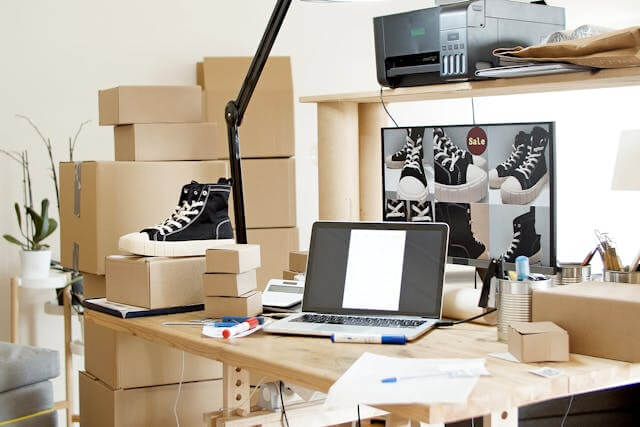
With your supplier selected, the next step is to design and customize your products. Since print on demand revolves around unique, made-to-order items, your designs should resonate with your niche audience.
How to Create Winning Designs
- Understand Your Audience – Research trends, colors, and styles that appeal to your target customers.
- Use Design Tools – Platforms like Canva, Adobe Illustrator, and Procreate help you create high-quality designs.
- Use AI and Mockup Generators – Many POD suppliers provide mockup generators to visualize how your designs will look on products.
Types of Designs That Sell Well
- Minimalist and typography-based designs (e.g., motivational quotes, pop culture references).
- Trendy and seasonal themes (e.g., holiday prints, meme-based designs).
- Niche-specific artwork (e.g., pet lovers, fitness enthusiasts, gamers).
Best Practices for High-Quality Prints
- Use high-resolution images – Ensure designs are 300 DPI to avoid pixelation.
- Follow print guidelines – Each POD supplier has specific file format and size requirements.
- Consider different printing methods – Some suppliers use DTG (Direct to Garment) printing for apparel, while others use sublimation for mugs and accessories.
Once your designs are ready, upload them to your POD supplier and generate mockups for your store. This will help showcase your products in a professional and appealing way.
Step 4: Set Up an Online Store
Now that everything is set, it’s time to set up your store. You can, of course, set up a store right after you decide what to sell as well. It’s entirely up to you.
But starting off, you have two options. Either sell on an online marketplace or set up your own online store. Let’s talk about what each method has to offer:
1. Selling on an Online Marketplace
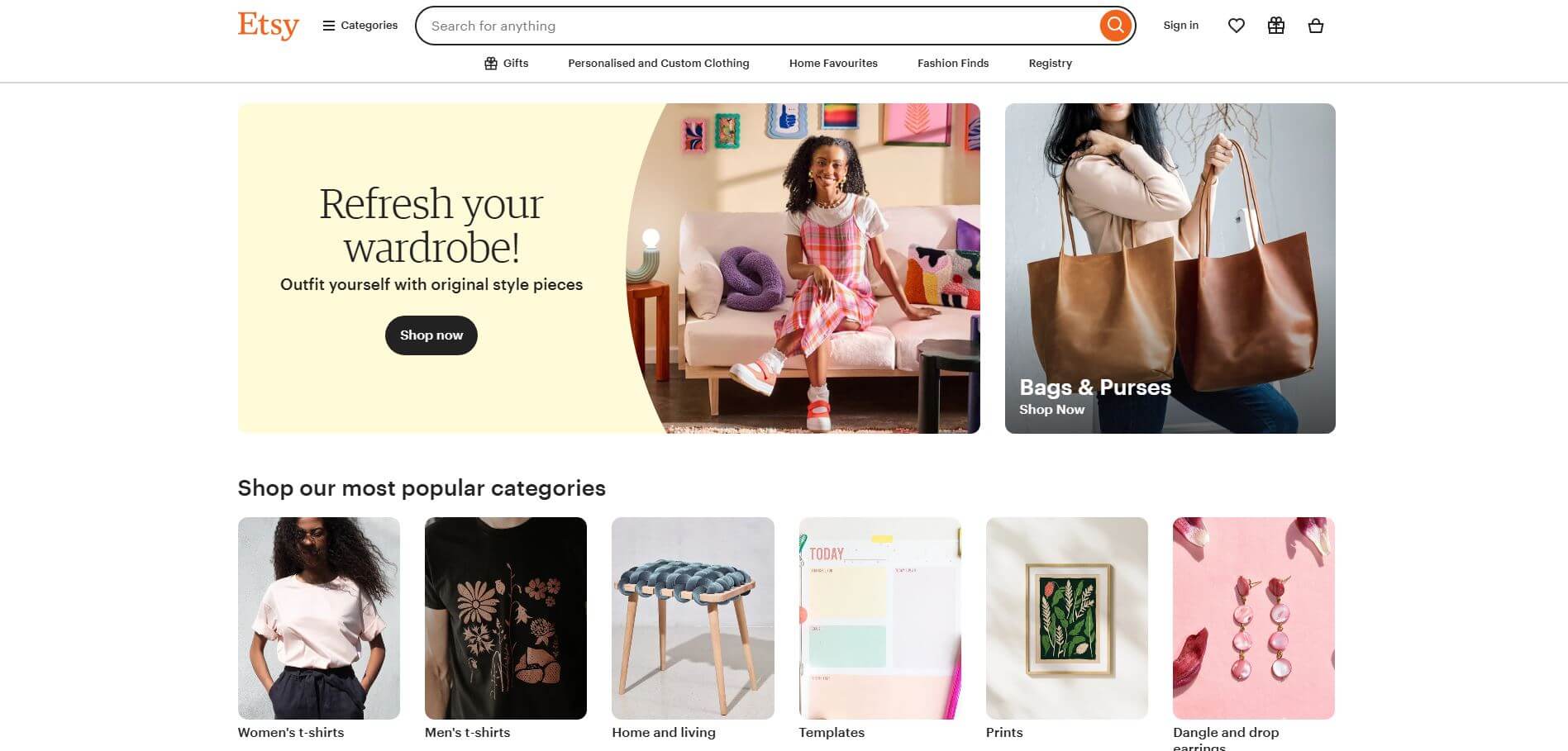
Many online marketplaces allow merchants to offer POD services.
The biggest benefit of choosing this route is you won’t have to do the legwork it takes to build an online presence as you get free traffic from the existing user base of the platform.
All you have to do is create an account, upload your listings and you can start selling on the site. This eliminates the hassle of buying hosting, designing the site, and other technicalities that come with building an online store.
However, there are also downsides to selling on online marketplaces. One of them is you will be completely dependent on the platform and won’t get the opportunity to do any branding of your own.
For whatever reason, if your account ever gets suspended from the marketplace you will go back to square one. Another problem is that most online marketplaces also have high competition.
Probably hundreds of other merchants are selling the same product, thus making it difficult for you to attract potential customers.
Obviously, it’s still possible to run a successful POD business by only selling on an online marketplace but if your main goal is to build a brand, then this method isn’t for you.
2. Creating Your Own Online Store
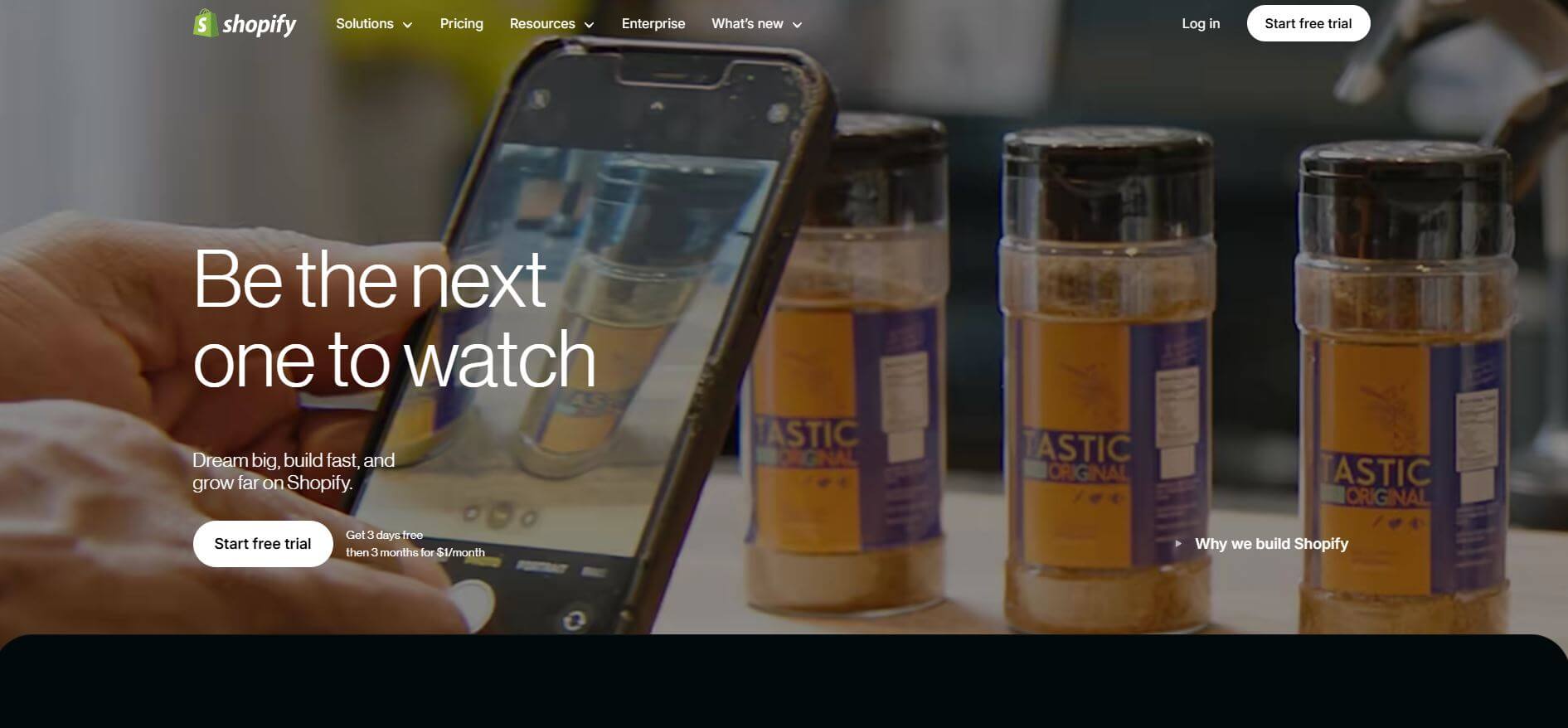
This method requires a bit more legwork as you first have to create an online store. Fortunately, there are plenty of online store builders like BigCommerce, Shopify and WooCommerce to make this part easier.
Most POD companies also offer easy integration with these platforms, allowing you to effortlessly sell online.
Your choice of eCommerce web builder mainly depends on your requirements and personal preferences. Compare their features and choose the one that best suits you — and create a logo and branding for your store while you’re at it! A professional-looking logo and brand identity will help you make a lasting impression on customers.
The biggest advantage of creating your own online store is you get full control over your brand. You don’t have to follow any strict rules or policies, nor worry about account suspensions.
As for the drawbacks, you’ll need a bit more investment and technical knowledge. Plus, there’s also the hurdle of creating a brand presence to generate traffic for your business.
Which Method Should You Choose?
Selling on an online marketplace is quite straightforward and also gives you access to free traffic.
But the biggest downside is you can’t build a brand, and most marketplaces also keep a commission, which will eat into your profit.
On the other hand, creating a store from scratch may sound like a staggering task, but it’s more fruitful in the long run as you will be able to establish your own brand.
To conclude, if you’re willing to put in the time and effort, then we would definitely recommend going with the second method.
Step 5: Set the Right Price for Your Products

Pricing can make or break your print-on-demand business. Set prices too high, and customers might look elsewhere.
Too low, and you’ll struggle to make a profit. So, how do you find the sweet spot?
Break Down Your Costs
Before setting your price, calculate all your expenses:
- Base product cost – The price your supplier charges for each item.
- Printing fees – Some POD platforms charge extra for certain prints or placements.
- Shipping fees – Whether you or your customer pays, it affects the final price.
- Platform fees – Marketplaces like Etsy or Amazon take a percentage of each sale.
- Marketing costs – Ads, influencer promotions, or other campaigns to attract buyers.
Decide on a Profit Margin
Most successful POD sellers aim for a 30-50% margin, but your pricing should also match market demand. Consider:
- Checking competitor prices on platforms like Etsy and Redbubble.
- Charging a premium if your designs are unique or offer added value.
- Adjusting pricing based on sales performance and customer feedback.
Experiment and Optimize
Pricing isn’t a one-time decision. To maximize sales, you can:
- Run promotions or discounts to attract new customers.
- Offer free shipping and include the cost in your product price.
- Test different pricing strategies (e.g., higher pricing with a discount vs. lower everyday pricing).
Once your pricing is set, it’s time for the next big step—marketing your store and making sales!
Step 6: Devise a Solid Marketing Strategy
Lastly, if you’re creating your own store, you will need a solid marketing plan from the start to succeed.
The marketing strategy of every eCommerce business varies according to its goals, product, and target audience.
However, here are some general tips to help you market your POD store, especially if you’re creating one from scratch:
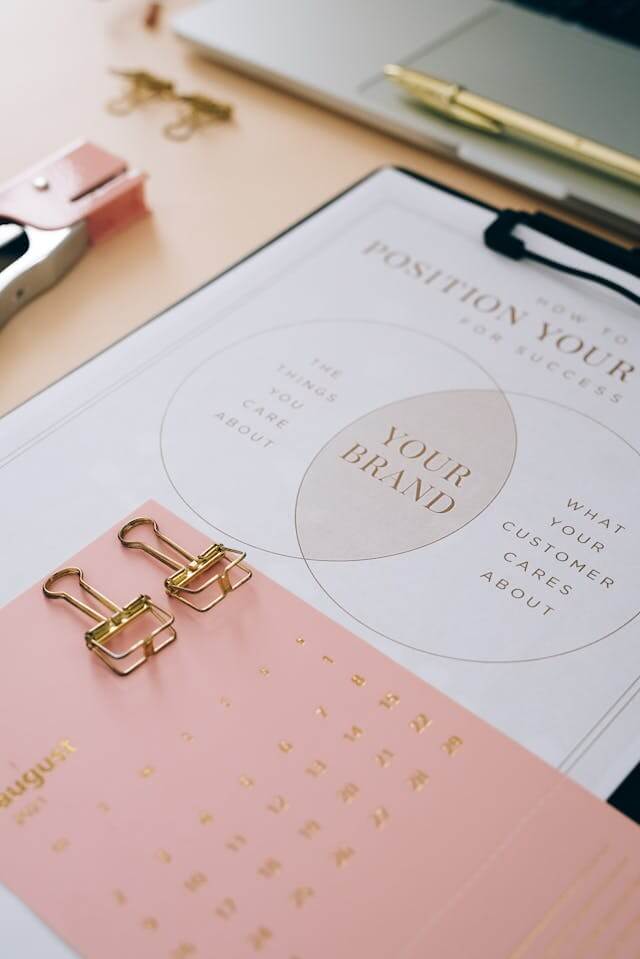
Social media marketing has become a must for businesses nowadays. It enables you to interact with millions of users worldwide and significantly helps in building a recognizable brand image.
The social media platform you choose to market your business mainly depends on the target audience and the type of product you’re planning to sell.
If your POD products involve jewelry, clothes, and other fashionable items, consider creating short clips for TikTok marketing. Another popular way to increase the reputation and visibility of a brand is by getting Instagram influencer shoutouts.
Regardless of the platform you choose, make sure that you stay active on your account and post daily content to engage with the audience.
2) Start a Blog
Blogging is one of the most effective ways to generate organic traffic to your site.
Although managing a blog takes a ton of time and effort, in the long run, it can significantly improve your ranking on the SERPs.
Besides, there are plenty of topics you could discuss in your POD blog ranging from different printing techniques, to products and designs, making it easy for you to create informative content.
3) Run Paid Ad Campaigns
Lastly, one of the most effective ways to generate traffic and increase conversions is to run paid ad campaigns. But beware that ad campaigns can cost a hefty amount of money.
You need to know your target audience to make the most out of your investment. Otherwise, you will get a ton of irrelevant traffic to your store.
The Pros and Cons of Print on Demand
Like any business model, print-on-demand (POD) comes with both advantages and challenges. Before diving in, it’s important to weigh the pros and cons to see if it’s the right fit for you.
Pros: Why Print on Demand is a Great Business Model
- Low Startup Costs – No need to buy inventory upfront. You only pay when a customer places an order.
- No Need for Warehousing – Your supplier handles production, storage, and shipping, saving you time and space.
- Wide Product Selection – From apparel to home decor, there are endless customization opportunities.
- Easy to Scale – As your store grows, you don’t have to worry about managing stock or fulfillment.
- Flexibility in Design – You can test new designs without financial risk since products are only created after a sale.
- Automation-Friendly – Many POD platforms integrate with Shopify, Etsy, and other marketplaces, making order processing seamless.
Cons: Challenges to Consider
- Lower Profit Margins – Since suppliers handle production and fulfillment, per-item costs are higher than bulk ordering.
- Limited Customization – Some POD providers have restrictions on print sizes, placement, and material choices.
- Longer Shipping Times – Since products are made-to-order, they take longer to ship compared to pre-stocked items.
- Quality Control Issues – You rely on your supplier for printing and fulfillment, which means less control over product quality.
- Competitive Market – Since POD has a low barrier to entry, standing out requires strong branding and marketing.
Tips to Successfully Run a Print on Demand Business
Launching a POD business might sound easy on paper, but quite a lot of complications can get in your way. So here are some tips and solutions for some common challenges you may face:
1) Work with Professional Designers

There’s no denying that appealing designs play an important role in the success of a POD business. But don’t worry because you don’t necessarily have to be a designer to create them.
You can commission those designs to professional artists, as long as you have a visual image of what you’re looking for and understand the key concepts of the POD business.
For starters, the designers should know that you’re outsourcing for printing purposes so they can prepare the design file according to the context and save the resolution at 300 dpi.
The printing area of the product should be of the same size as the dimensions of the images.
The specifications for the print may vary depending on the printing technique. Always send the changed specs to the designer to avoid miscommunication.
2) Validate Your Ideas
Just because you like a design, doesn’t mean your customers would share the same sentiments.
At the end of the day, you’ll only generate profit from a POD business if the consumers like the design and quality of the product you’re offering.
This is why, before finalizing a design idea, try knowing what your target audience thinks about it.
Upload the design on your social media accounts, and also on popular forums like Reddit to get direct feedback from the public.
If you don’t want to publicly reveal it, then just share it with some of your brutally honest friends.
3) Create Mockups of Your Products
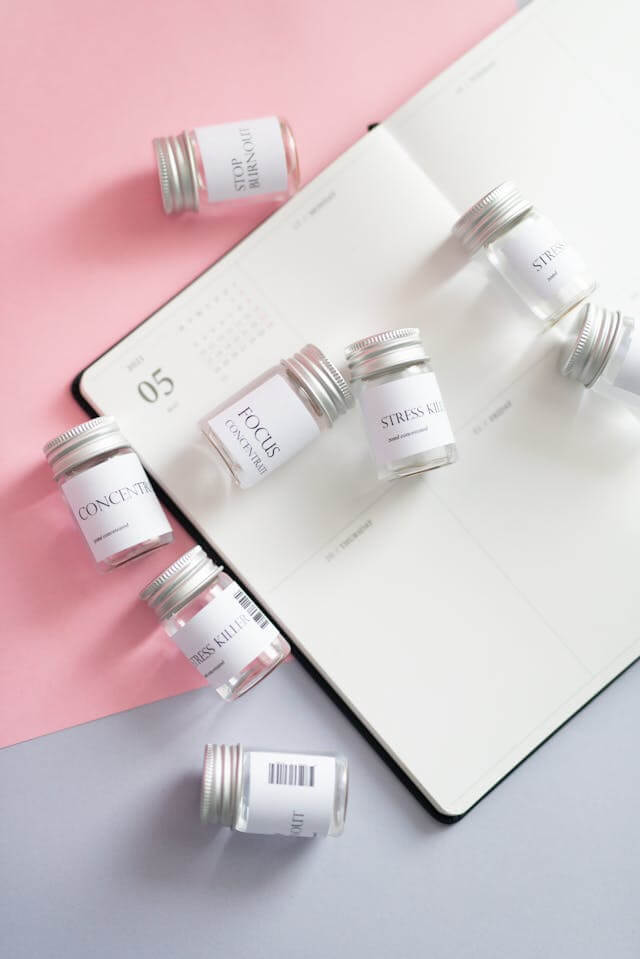
Most of the popular POD companies have a mockup tool that gives you a glimpse of what the final product will look like.
In case the platform doesn’t have a mockup generator, you can search for online templates or use Photoshop or other editing tools.
If you don’t know how to use it then try learning it by watching an online tutorial because going the extra mile really is worth it.
4) Always Test the Product Quality
Quality assurance is an essential part of running a successful POD business. Your product should look and feel exactly the same as you describe it to your customers.
There’s no way of individually checking every product before shipping, but you can still be your own customer and order samples to verify if the supplier is meeting the desired quality standard.
You can also take this opportunity to click some attractive product images that you can upload to your site – so basically, it’s a win-win situation.
5) Be Upfront about Shipping Times
You don’t really have much control over the shipping time of the product. But you can control the customer expectations by not making unrealistic commitments.
It’s important to consider that the lead time of POD products is generally higher because they’re prepared on a per-order basis. Keeping that in mind, you want to at least keep a margin of 2-3 days for production.
After that, calculate the transit time based on the distance and the shipping method being used. If you aren’t honest about shipping times from the start then your inbox will soon swarm with shipping-related questions.
We recommend creating a separate shipping-related FAQ section addressing all the common queries of the customers, so you don’t have to explain it to everyone individually.
6) Offer Bundles and Discounts

The profit margin in a POD business is generally considered to be low. That’s because most POD products are inexpensive. If you want to increase your profit, then you need to start getting a higher volume of sales.
For that, you have to be more creative with your marketing. Try offering bundle discounts to your customers like selling a bundle of 3 t-shirts for $27 instead of $30.
If possible, try adding complementary items with the main products. Free shipping on a certain order value can also act as a sweetener in helping you bag more sales.
Overall, there are a ton of creative marketing tactics you can use to promote your POD business. Experiment around to see what works best.
FAQs about How to Start a Print on Demand Business
Is Print on Demand Worth It in 2025?
Absolutely! If you’re looking for a low-risk way to start an online business, print on demand is still a great option in 2025.
Consumers are increasingly looking for unique, personalized products, and the demand for niche apparel, accessories, and home decor is only growing.
With better printing technology, faster fulfillment, and a wider range of customizable items, it’s easier than ever to create high-quality products without managing inventory. However, like any business, success isn’t guaranteed.
You’ll need to choose the right niche, work with reliable suppliers, and invest in marketing to stand out. If you’re willing to put in the effort, POD can be a profitable and scalable business model.
Is Print on Demand Profitable?
Whether Print on Demand is profitable or not depends on your expectations. If your main goal is to just generate a monthly passive income then yes, POD can help you achieve that.
However, don’t keep your expectations too high as you can’t make a fortune with POD alone.
How Much Money Do I Need to Start a POD Business?
Starting a POD business requires minimal upfront investment compared to traditional eCommerce. Here’s a basic breakdown of potential costs:
- Ecommerce Platform – Free (Etsy) to $29/month (Shopify Basic)
- Domain Name – Around $10–$20/year
- Design Software or Tools – Free (Canva) to $10–$30/month (Adobe Photoshop)
- Marketing Budget – Depends how much you want to spend but $50–$200/month can help with ads and influencer marketing
Since you don’t need to buy inventory upfront, the biggest expense will likely be marketing and branding.
Do You Need a License for Print on Demand?
In most cases, you don’t need a special license to start a POD business. However, here are some things to consider:
- Business Registration – If you plan to scale, registering your business as an LLC or sole proprietorship might be beneficial.
- Tax and Legal Compliance – Depending on your location, you may need a sales tax permit or EIN (Employer Identification Number).
- Copyright and Trademark Laws – Avoid using copyrighted images or brand names in your designs to prevent legal issues.
If you’re unsure about legal requirements, consulting a business attorney or accountant is a good idea.
How to Promote Your Print on Demand Business?
There are multiple ways to promote your POD business. You can start with social media marketing, run paid ad campaigns, start a blog, or even create an email list.
Try exploring different marketing strategies to see which one works best for your business.
How Much Can You Make with Print on Demand?
The amount of money you can make with Print on Demand depends on the type of product, your marketing efforts, and your target audience.
If you’re selling two products each day and keeping a profit of $5 on it, then you’ll make $300 per month.
We know this doesn’t sound a lot, but the profit grows depending on the volume of sales, so it isn’t possible to give concrete numbers.
Final Thoughts
The Print on Demand service is great for those who want to test a product before fully investing in it.
You can try out thousands of white-label products with an immeasurable number of different designs and combinations.
If you find a winning product, you can start enjoying a steady passive income. If not, go back to the drawing board to generate new ideas.
Overall, the flexibility Print on Demand offers makes it a great business model, especially for beginners.
However, POD does have its drawbacks like you can only sell limited products and it offers a low profit margin.
If you don’t like the product restrictions of this model then perhaps dropshipping would be the better choice.
You don’t have to worry about product sourcing either as NicheDropshipping can help you source and private label your desired products at competitive prices.
Want to learn more about our services? Just give us a call and one of our agents will happily guide you!
